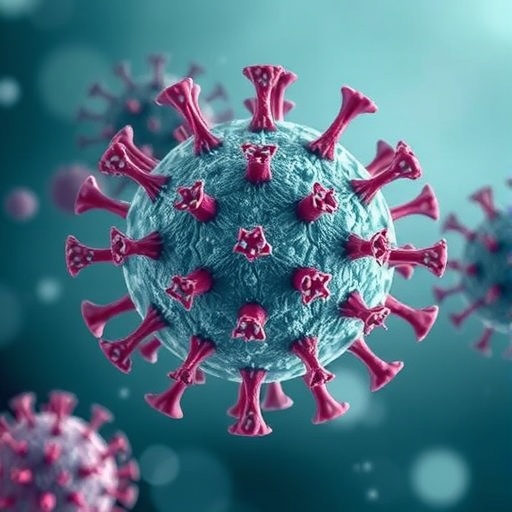As the global crisis of plastic pollution escalates, new research is uncovering an alarming potential threat that extends beyond environmental degradation. Tiny airborne fragments of plastic, known as microplastics and nanoplastics, are emerging as possible hidden carriers for viruses, potentially affecting the transmission dynamics of respiratory diseases. This possibility introduces a complex and urgent intersection between environmental science and infectious disease that demands rigorous scientific exploration.
Microplastics, typically defined as plastic particles smaller than 5 millimeters, and nanoplastics, which are even tinier, have become ubiquitous contaminants in air, water, and soil. While much attention has historically focused on the impact of plastic pollution on marine ecosystems, emerging data reveals that these particles are airborne in significant quantities, especially in urban and indoor environments. In some indoor settings, concentrations of airborne microplastics have been measured at astonishing levels, reaching hundreds of particles per cubic meter of air, leading to daily human inhalation of tens of thousands of these particles.
The implications of these microscopic plastics acting as vectors for viruses hinge on their physical and chemical properties. Their particle size overlaps substantially with that of many human respiratory viruses, allowing for plausible direct interactions. Moreover, their lightweight nature and carbon-based composition enable them to remain suspended in the atmosphere for extended durations, enhancing the possibility of long-range viral transport. Unlike inert inorganic particles, microplastics’ surfaces can host a complex microbiome, including bacteria and fungi. These microbial hitchhikers may provide protective microenvironments that shield viruses from ultraviolet radiation and environmental desiccation, factors known to rapidly reduce viral viability in aerosols.
Laboratory studies on the adhesion of viruses to airborne particulate matter have laid foundational evidence supporting this hypothesis. Influenza A virus, for instance, has demonstrated the ability to attach to particulate matter and retain infectivity during airborne transport. Microplastics, which tend to persist longer in the atmosphere due to unique physicochemical characteristics, could theoretically provide an even more efficient vector for virus survival and dissemination. This concept challenges existing paradigms of viral transmission, which primarily consider respiratory droplets and fomites, by introducing airborne plastics as an overlooked but potentially critical factor.
The recent COVID-19 pandemic offers a compelling case study. Research has established that SARS-CoV-2 can remain viable on plastic surfaces for upwards of a week, underscoring the stability of viruses on polymer substrates. Epidemiological investigations, such as those analyzing the Diamond Princess cruise ship outbreak, suggested that surface contamination contributed significantly to virus spread, with estimates attributing as much as 30% of infections to contact with contaminated surfaces. If such viral persistence extends to plastic fragments suspended in air rather than just solid surfaces, there is a profound implication for airborne viral transmission routes, necessitating urgent research.
Despite compelling circumstantial evidence, it is critical to emphasize that definitive proof linking airborne micro- and nanoplastics to active viral transmission does not currently exist. The hypothesis remains scientifically plausible yet unconfirmed, requiring well-designed laboratory experiments and epidemiological studies to ascertain the potential for airborne plastics to harbor viable viruses in real-world conditions. Key research priorities include quantifying viral load adherence rates on plastic particles, elucidating environmental factors that enable viral survival, and establishing epidemiological correlations between airborne plastic exposure and infection rates.
If this hypothesis withstands scientific scrutiny, the public health ramifications would be enormous. Urban centers and enclosed spaces known to harbor elevated airborne plastic concentrations—due to sources like synthetic textiles, plastic packaging, and industrial emissions—could face novel risks for respiratory disease propagation. Mitigating these risks would call for innovative approaches, such as developing air filtration technologies specifically designed to capture microplastics, alongside stricter regulatory measures aimed at curbing airborne plastic discharge.
The broader environmental context cannot be ignored when considering this research frontier. Global plastic production has surged dramatically, exceeding 540 million metric tons as of 2020, with projections indicating continued exponential growth. The fragmentation of this endless plastic supply chain generates vast quantities of micro- and nanoplastics worldwide, distributing them into every ecosystem and increasingly into the air we breathe. Understanding the biological interactions between these particles and pathogenic viruses bridges environmental pollution with infectious disease epidemiology in an unprecedented way.
Addressing this challenge necessitates interdisciplinary collaboration spanning virology, environmental science, aerosol chemistry, and public health policy. Such a holistic approach is essential to elucidate the mechanisms by which airborne plastics could influence viral infectivity and spread. The consequences of ignoring this intersection might be underrecognized disease transmission pathways, complicating pandemic control efforts and straining healthcare infrastructure.
Beyond immediate health concerns, this research highlights the interconnectedness of planetary and human health. By reframing plastics from inert pollutants to active participants in disease ecology, scientists underscore the need for integrated environmental stewardship and public health strategies. Protecting human populations against emerging infectious threats requires recognizing and mitigating all potential vectors, including those once thought irrelevant, such as airborne micro- and nanoplastics.
In conclusion, the possibility that micro- and nanoplastics suspended in air act as hidden vectors for human viral infections represents an urgent and underexplored frontier in both environmental and medical research. While definitive evidence remains to be gathered, the weight of current scientific understanding supports prioritizing this avenue of inquiry. Doing so will be essential for developing effective preventative measures to safeguard health in a rapidly evolving environmental landscape increasingly dominated by synthetic pollutants.
Subject of Research: Not applicable
Article Title: Airborne micro- and nanoplastics: hidden vectors for human infection?
News Publication Date: 28-Oct-2025
Web References:
https://www.maxapress.com/newcontam
References:
Wu M, Zhong H. 2025. Airborne micro- and nanoplastics: hidden vectors for human infection? New Contaminants 1: e009. DOI: 10.48130/newcontam-0025-0010
Image Credits: Mengjie Wu, Huan Zhong
Keywords: Health care




